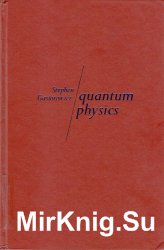Quantum Physics
- Добавил: alex66
- Дата: 15-07-2018, 08:24
- Комментариев: 0

Название: Quantum Physics
Автор: Stephen Gasiorowicz
Издательство: John Wiley & Sons
Год: 1974
Формат: PDF
Страниц: 531
Размер: 21.76 МБ
Язык: English
This book is intended to serve as an introduction to quantum physics. In writing it, I have kept several guidelines in mind.
1. First, it is helpful for the development of intuition in any new field of study to start with a base of detailed knowledge about simple systems. I have therefore worked out a number of problems in great detail, so that the insight thus obtained can be used for more complex systems.
2. Every aspect of quantum mechanics has been helpful in understanding some physical phenomenon. I have therefore laid great stress on applications at every stage of the development of the subject. Although no area of quantum physics is totally developed, my intention is to bridge the gap between a modern physics course and the more formal development of quantum mechanics. Thus, many applications are discussed, and I have stressed order-of-magnitude estimates and the importance of numbers.
3. In keeping with the level of the book, the mathematical structure has been kept as simple as possible. New concepts, such as operators, and new mathematical tools necessarily make their appearance. I have dealt with the former more by analogy than by precise definition, and I have minimized the use of new tools insofar as possible.
In approaching quantum theory, I chose to start with wave mechanics and the Schrodinger equation. Although the state-vector approach gets at the essential structure of quantum mechanics more rapidly, experience has shown that the use of more familiar tools, such as differential equations, makes the theory more accessible and the correspondence with classical physics more transparent.
The book probably contains a little more material than can comfortably be covered in one year. The basic material can be covered in one academic quarter.
It consists of Chapters 1 to 6, 8, and 9, in which the motivation for a quantum theory, the Schrodinger equation, and the general framework of wave mechanics are covered. A number of simple problems are solved in Chapter 5, and their relevance to physical phenomena is discussed. The generalization to many particles and to three dimensions is developed. The second-quarter material deals directly with atomic physics problems and uses somewhat more sophisticated tools. Here we discuss operator methods (Chapter 7), angular momentum (Chapter 10), the hydrogen atom (Chapter 12), operators, matrices, and spin (Chapter 14), the addition of angular momenta (Chapter 15), time-independent perturbation theory (Chapter 16), and the real hydrogen atom (Chapter 17). This material prepares the student to cope with a large variety of problems that are discussed during the third and last quarter. These problems include the interaction of charged particles with a magnetic field (Chapter 13), the helium atom (Chapter 18), problems in the radiation of atoms and related topics (Chapters 22 and 23), collision theory (Chapter 24), and the absorption of radiation in matter (Chapter 25). This material is supplemented by a more qualitative discussion of the structure of atoms and molecules (Chapters 19 to 21). The last chapter on elementary particles and their symmetries serves the dual purpose of describing some of the recent advances on that frontier of physics and of showing how the basic ideas of quantum theory have found applicability in the domain of very short distances.
Several topics arise naturally as digressions in the development of the subject matter. Instead of lengthening some long chapters, I have placed this material in a separate "Special Topics” section. There, relativistic kinematics, the equivalence principle, the WKB approximation, a detailed treatment of lifetimes, line widths and scattering resonances, and the Yukawa theory of nuclear forces are discussed. For the same reason, a brief introduction to the Fourier integral, the Dirac delta function, and some formal material dealing with operators have been placed in mathematical appendices at the end of the book.
I am indebted to my colleagues at the University of Minnesota, especially Benjamin Bayman and Donald Geffen, for many discussions on the subject of quantum mechanics. I am grateful to Eugen Merzbacher, who read the manuscript and made many helpful suggestions for improvements. I also thank my students in the introductory quantum mechanics course that I taught for several years. Their evident interest in the subject led me to the writing of the supplemental notes that later became this book.
Stephen Gasiorowicz
Внимание
Уважаемый посетитель, Вы зашли на сайт как незарегистрированный пользователь.
Мы рекомендуем Вам зарегистрироваться либо войти на сайт под своим именем.
Уважаемый посетитель, Вы зашли на сайт как незарегистрированный пользователь.
Мы рекомендуем Вам зарегистрироваться либо войти на сайт под своим именем.
Информация
Посетители, находящиеся в группе Гости, не могут оставлять комментарии к данной публикации.
Посетители, находящиеся в группе Гости, не могут оставлять комментарии к данной публикации.
